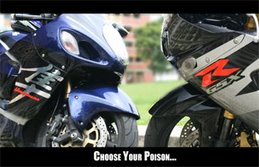The bikes these days are now slowly replacing the use of carburettors with fuel injection (FI) systems. The carburettor itself is quite an amazing piece of component controlling the amount of fuel that gets into the combustion chamber. It is something that the modern fuel injection system tries to emulate with the use a wide array of sensors and a microprocessor.
The following are a few essential components of the fuel injection system. This part will just be covering how fuel is actually being delivered into the combustion chamber (injection as opposed to suction). The amount of fuel delivered (injection duration) will be covered in a later part.
Fuel Pump - an electric powered motor that draws fuel from the inlet port and pushes it out through the outlet port. This provides a source of pressurised fuel that is essential in the functioning of the fuel injection system.
Fuel Regulator - a mechanical component that as it name suggests; regulates the fuel. A spring valve system in the fuel regulator ensures that the pressure of the fuel system is maintained. This allows the amount of fuel injected to be precisely controlled. Any changes to the fuel pressure will result in a drastic change in the fuel delivery into the combustion chamber. Injectors - a solenoid controls the plunger that connects to a needle valve. When a voltage is applied, the needle valve is opened and due to the pressure in the fuel system, the fuel shoots out from the injector. The injectors will used in the normal operation of the engine, the injectors will be turned on and off in pulses, known as injector pulses.
Injectors - a solenoid controls the plunger that connects to a needle valve. When a voltage is applied, the needle valve is opened and due to the pressure in the fuel system, the fuel shoots out from the injector. The injectors will used in the normal operation of the engine, the injectors will be turned on and off in pulses, known as injector pulses.
Knowing how the fuel delivered is the groundwork to explore how to properly deliver correct amount of fuel based on the engine's requirement. That's another topic for another time.
11 December, 2007
Fuel Injection (Part 1) - Fuel Delivery
Posted by kaieiru at 11:01
Labels: fuel injection


